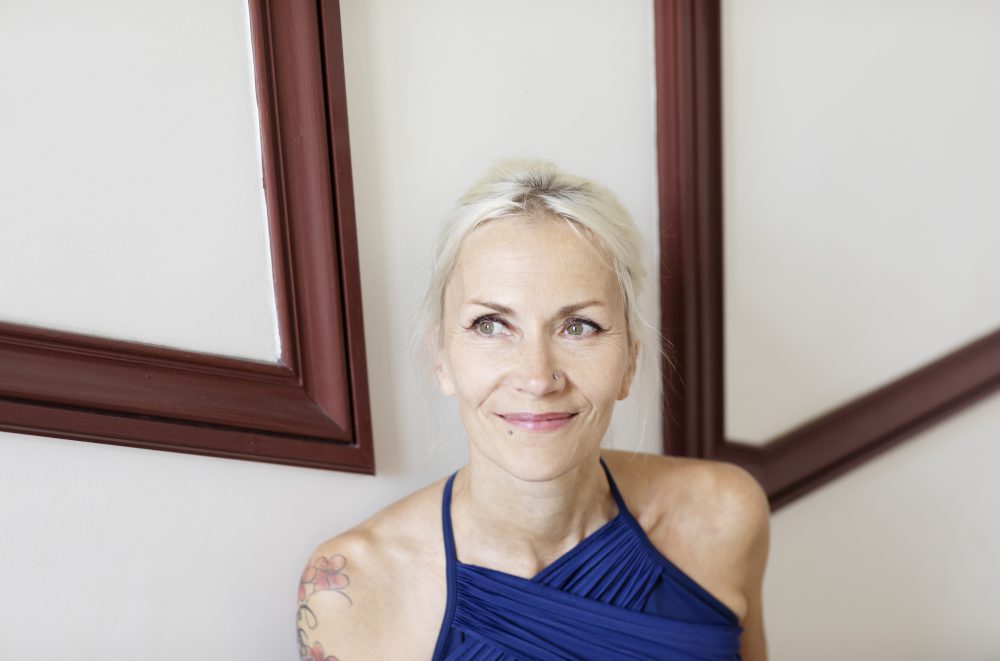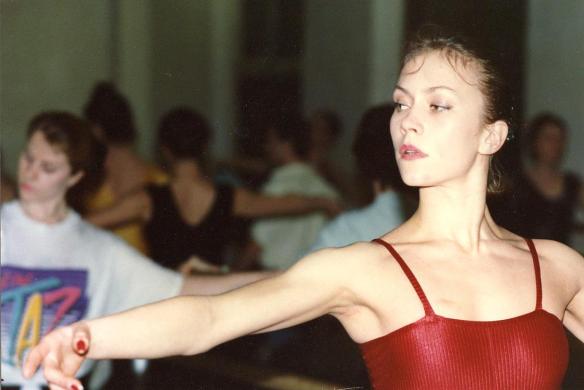I found my earthly paradise in Paris. A paradise in general, but especially a paradise of dance. The dynamicity and the beauty of the city contribute to the great energy of the classes, but my heavenly feelings are mostly thanks to my fantastic teachers. The presence of each and every teacher I have is electric and electrifying. Their inner freedom affects me profoundly and is synonym of love for me.
The maestros in dance are like the yoga gurus in yoga. They show us how to discover new potential in ourselves. They make us transparent and that’s what transforms us and reveals our soul. In dance classes you can see dancers who are criticizing themselves all the time. They are watching a film of their ideal self inside their minds and that makes them tense and unhappy. They are not living their body, but the film. In the yoga world I can quite often see unhappy faces, competing minds, tense bodies, serious people. That’s where I feel that people have got lost with their practice. If you don’t love yourself, what’s left? Self-suffiency. The teacher can be in the same world: criticizing and being too demanding and strict instead of loving and making students grow in joy. The real maestros and gurus see through us, the obstacles we create and they can stop the film we’re watching.
Yves Casati, one of my ballet teachers has a presence which makes me immediately feel myself lighter. He shows up and I feel dancing inside. I can feel my energy expanding and re-directing itself. In the beginning of the class Maestro Casati tells us to look at our hand with love and to move it with love. It doesn’t mean pretending love, we need to find it for real. Without that, why would we even danse? Why would we repeat movements with our body if we don’t feel anything? “Show your love!”, he tells us.
When the joy is gone, the body is tense and heavy and we become its prisoners. When we practice with effort, there’s no love. When we practice with love, there’s actually no effort. This is valid in yoga, in danse, in anything. When there’s a profound joy and freedom in us, our body is carried by it and it can express itself naturally. An effort then becomes meaningless, the energy is enough to do miracles. What I find personally fabulous is that almost every time I leave a dance class, I’m transformed, I’m a new person. I’m something more than I was before the class.
The best teachers for me are those who love. Those who love life and want to transmit this love to others. No matter actually if it’s the love through painting, dancing or yoga, but without love and freedom nothing really matters! If you find love and joy, then your practice is love and joy. The thing is to learn to love yourself and to learn to express it. To be touched by new openings and take them to your life. Dance for me is showing my love for my life. The yoga practice keeps my channels open to express that love.
APPRENTI AMOUR
J’ai trouvé mon paradis terrestre à Paris. Un paradis tout court, mais plus spécialement, un paradis de danse. L’entrain et la beauté de la ville contribuent évidemment à l’énergie magnifique des cours, mais c’est surtout grâce à mes professeurs fantastiques que j’y vis des moments sublimes. La présence de chacun d’eux est électrique et électrisante. Leur liberté intérieure me touche profondément et est le synonyme de l’amour pour moi.
Les maîtres de danse ont le même rôle dans la danse que les gourous en yoga. Ils nous montrent comment trouver notre vrai potentiel. Ils nous rendent transparents et ceci faisant, ils nous transforment et révèlent notre âme. Dans les cours de danse, il y a toujours quelques danseurs qui se critiquent continuellement. Ils se projettent un film à l’intérieur de leur moi idéal et cela les rend mécontents d’eux-mêmes. Ils ne vivent pas leurs corps, mais le film. Dans le yoga, je peux voir la même chose de temps en temps: des visages maussades, des mentaux pleins de compétition, des corps tendus, des gens sérieux. C’est là, que je me dis que les gens se sont perdus dans leur pratique. Si nous ne nous aimons pas, qu’est-ce qui nous reste-t-il? La prétention? Le professeur peut partager la même mentalité où il n’encourage pas le progrès des élèves par la joie. Les vrais maîtres et gourous voient à travers nous, ils comprennent les obstacles que nous crééons pour nous-mêmes et ils ont la capacité d’arrêter le film que nous sommes en train de regarder.
Yves Casati, un de mes professeurs de danse classique, a une présence tellement impressionnante que je me sens immédiatement plus légère en le voyant. Il apparaît et la danse commence à l’intérieur de moi. Je peux sentir une expension et une nouvelle organisation dans mon énergie. Au début du cours, maître Casati nous dit de regarder notre main avec amour et de la bouger avec amour. Ceci ne veut absolument pas dire qu’il faille prétendre cet amour, nous devons le trouver en nous pour de vrai. Sans l’amour, pourquoi danserions-nous? Pourquoi répéterions-nous des pas si nous sentons rien? “Montrez votre amour!”, il nous rappelle.
Quand il n’y a pas de joie, le corps est tendu et lourd et nous devenons ses prisonniers. Lorsque nous pratiquons avec beaucoup d’effort, il n’y a pas d’amour. Lorsque nous pratiquons avec de l’amour, il n’y a pratiquement pas d’effort. Cela est vrai en yoga, en danse, en presque tout ce qu’on fait. Quand il y a une joie profonde et une liberté en nous, notre corps est porté par cette joie et il peut s’exprimer dune façon naturelle. Là, l’effort devient superflu, car l’énergie elle-même nous fait faire des miracles. Ce que je trouve personnellement fabuleux, c’est qu’à chaque fois que je sors d’un cours de danse, je suis transformée, je suis une nouvelle personne. Je suis quelque chose de plus que je n’étais avant la classe.
Les meilleurs professeurs pour moi, ce sont ceux qui ont de l’amour. Ceux qui aiment la vie et qui veulent transmettre cet amour aux autres. Que ce soit à travers la peinture, la danse ou le yoga, ça n’a pas d’importance, mais sans amour et liberté rien n’a vraiment d’importance. Quand nous trouvons la joie et l’amour, notre pratique n’est que de la joie et de l’amour. Nous devons apprendre à nous aimer et à l’exprimer. À trouver de nouvelles possibilités et à les embrasser. La danse pour moi est avant tout le moment de montrer combien j’aime la vie. La pratique du yoga m’aide à maintenir ouvert tous les canaux pour exprimer cet amour pleinement.
RAKKAUDEN OPETTELUA
Löysin Pariisista oman maanpäällisen paratiisini. Kaiken muun autuuden ohella, Pariisi on minulle myös tanssiparatiisi. Kaupungin dynaamisuus ja kauneus toki heijastuvat myös tanssituntien tunnelmiin, mutta omat taivaita hipovat olotilani luen suurimmaksi osaksi fantastisten opettajieni ansioksi. Heidän jokaisen läsnäolo on sähköistä ja sähköistävää. Heidän sisäisen vapautensa suuruus koskettaa minua syvästi ja herättää minussa valtavan rakkauden.
Tanssimaestroilla on tanssin piirissä sama rooli kuin guruilla joogassa. He näyttävät meille todellisen potentiaalimme. Tekemällä meistä läpinäkyviä he saavat meissä aikaan muutoksen ja sielumme kukoistamaan. Tanssitunneilla tapaa toisinaan tanssijoita, jotka ovat jatkuvassa itsekritiikin tilassa. He näkevät mielessään kuvan ideaaliminästään ja se tekee heistä jännittyneitä ja onnettomia. He eivät eläkään kehoaan, vaan tätä kuvaa. Joogan parissakin näkee monesti äreitä ilmeitä, kilpailuhenkistä mieltä, jännittyneitä kehoja ja ylipäätään vakavia ihmisiä. Minusta tuntuu, että silloin ihmiset ovat eksyksissä harjoituksensa kanssa. Jos emme rakasta itseämme, mitä jää jäljelle? Itsetyytyväisyys ehkä. Opettaja voi olla ihan samassa maailmassa, kritisoida ja olla tiukka sen sijaan että olisi rakastava ja antaisi oppilaiden kasvaa ilon kautta. Todelliset mestarit näkevät lävitsemme ja havaitsevat ne esteet, joita itse luomme tiellemme. Heillä on myös kyky pysäyttää mielessämme pyörivä filminauha.
Erään suosikkibalettiopettajani, Yves Casatin, läsnäolo saa minut välittömästi tuntemaan itseni kevyemmäksi. Kun hän ilmestyy paikalle, tunnen tanssin alkavan sisälläni. Energia laajenee ja ojentuu uudella tavalla kehossani. Aina tuntien alussa Maestro Casati muistuttaa meitä siitä, että varmasti seuraamme kättämme rakastavalla katseella ja liikutamme sitä rakkaudella. Se ei todellakaan tarkoita rakkauden esittämistä, vaan aidon tunteen täytyy löytyä sisältämme. Ilman rakkautta, miksi edes tanssisimme? Miksi toistelisimme liikkeitä, jos emme tunne mitään? “Näyttäkää rakkautenne”, hän vaatii.
Kun meistä puuttuu ilo, keho on jäykkä ja raskas ja meistä tulee sen vankeja. Kun harjoittelumme on ponnistelua, ei rakkaus pääse esiin. Ja kun taas harjoittelumme lähtee rakkaudesta, ponnistelua ei tarvita. Tämä pätee joogaan, tanssiin, oikeastaan kaikkeen. Kun sisällämme on syvä ilo ja vapaus, se kantaa kehoamme ja ilo puhuu sen kautta. Ponnistelulla ei ole enää mitään sijaa, koska pelkkä energiamme riittää ihmeiden aikaansaamiseen. Henkilökohtaisesti koen, että on käsittämätöntä miten jokaisen tanssitunnin jälkeen olen uusi ihminen. Olen aina enemmän kuin mitä olin ennen tuntia.
Minulle parhaat opettajat ovat niitä, jotka rakastavat. Niitä, jotka rakastavat elämää ja haluavat jakaa sitä muille. Sillä mitä opetetaan, ei ole niin väliä, mutta taas ilman rakkautta ja vapautta millään ei oikeastaan ole väliä. Kun löydämme rakkauden ja ilon, harjoittelumme on rakkautta ja iloa. On tärkeää oppia rakastamaan itseään ja löytää sen ilmaisemiselle kanavia. Löytää uusia mahdollisuuksia ja ottaa ne vastan omassa elämässä. Minulle tanssi on se minkä kautta voin ilmaista väkevimmin rakkauteni elämää kohtaan. Joogaharjoittelu pitää kanavani auki siten, että rakkauden kokonaisvaltainen ilmaiseminen on mahdollista.
Behind this door – love. ❤





